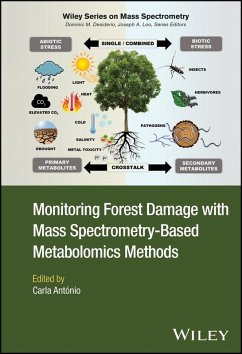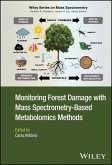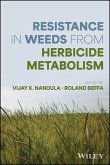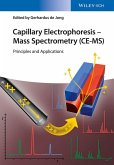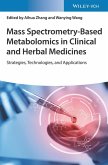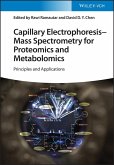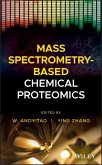Monitoring Forest Damage with Mass Spectrometry-Based Metabolomics Methods (eBook, ePUB)
Redaktion: Antonio, Carla
142,99 €
142,99 €
inkl. MwSt.
Sofort per Download lieferbar

0 °P sammeln
142,99 €
Als Download kaufen

142,99 €
inkl. MwSt.
Sofort per Download lieferbar

0 °P sammeln
Jetzt verschenken
Alle Infos zum eBook verschenken
142,99 €
inkl. MwSt.
Sofort per Download lieferbar
Alle Infos zum eBook verschenken

0 °P sammeln
Monitoring Forest Damage with Mass Spectrometry-Based Metabolomics Methods (eBook, ePUB)
Redaktion: Antonio, Carla
- Format: ePub
- Merkliste
- Auf die Merkliste
- Bewerten Bewerten
- Teilen
- Produkt teilen
- Produkterinnerung
- Produkterinnerung

Bitte loggen Sie sich zunächst in Ihr Kundenkonto ein oder registrieren Sie sich bei
bücher.de, um das eBook-Abo tolino select nutzen zu können.
Hier können Sie sich einloggen
Hier können Sie sich einloggen
Sie sind bereits eingeloggt. Klicken Sie auf 2. tolino select Abo, um fortzufahren.

Bitte loggen Sie sich zunächst in Ihr Kundenkonto ein oder registrieren Sie sich bei bücher.de, um das eBook-Abo tolino select nutzen zu können.
Understand forest responses to climate change with this timely introduction Forests are among the most critical parts of our global ecosystem, responsible for the air we breathe, home to most of the earth's species, and crucial sources of food and raw materials. Forest development is therefore one of the most important areas of ecological study, and damage to forests is potentially existential. Metabolomics, a toolkit which accrues data on interactions between genetic and environmental conditions, promises to advance our understanding of how these vital ecosystems respond to dramatic changes…mehr
- Geräte: eReader
- mit Kopierschutz
- eBook Hilfe
- Größe: 20.67MB
Andere Kunden interessierten sich auch für
![Monitoring Forest Damage with Mass Spectrometry-Based Metabolomics Methods (eBook, PDF) Monitoring Forest Damage with Mass Spectrometry-Based Metabolomics Methods (eBook, PDF)]() Monitoring Forest Damage with Mass Spectrometry-Based Metabolomics Methods (eBook, PDF)142,99 €
Monitoring Forest Damage with Mass Spectrometry-Based Metabolomics Methods (eBook, PDF)142,99 €![Resistance in Weeds from Herbicide Metabolism (eBook, ePUB) Resistance in Weeds from Herbicide Metabolism (eBook, ePUB)]() Resistance in Weeds from Herbicide Metabolism (eBook, ePUB)156,99 €
Resistance in Weeds from Herbicide Metabolism (eBook, ePUB)156,99 €![Capillary Electrophoresis - Mass Spectrometry (CE-MS) (eBook, ePUB) Capillary Electrophoresis - Mass Spectrometry (CE-MS) (eBook, ePUB)]() Gerhardus De JongCapillary Electrophoresis - Mass Spectrometry (CE-MS) (eBook, ePUB)142,99 €
Gerhardus De JongCapillary Electrophoresis - Mass Spectrometry (CE-MS) (eBook, ePUB)142,99 €![Mass Spectrometry-Based Metabolomics in Clinical and Herbal Medicines (eBook, ePUB) Mass Spectrometry-Based Metabolomics in Clinical and Herbal Medicines (eBook, ePUB)]() Mass Spectrometry-Based Metabolomics in Clinical and Herbal Medicines (eBook, ePUB)133,99 €
Mass Spectrometry-Based Metabolomics in Clinical and Herbal Medicines (eBook, ePUB)133,99 €![Capillary Electrophoresis - Mass Spectrometry for Proteomics and Metabolomics (eBook, ePUB) Capillary Electrophoresis - Mass Spectrometry for Proteomics and Metabolomics (eBook, ePUB)]() Capillary Electrophoresis - Mass Spectrometry for Proteomics and Metabolomics (eBook, ePUB)115,99 €
Capillary Electrophoresis - Mass Spectrometry for Proteomics and Metabolomics (eBook, ePUB)115,99 €![Mass Spectrometry-Based Chemical Proteomics (eBook, ePUB) Mass Spectrometry-Based Chemical Proteomics (eBook, ePUB)]() Mass Spectrometry-Based Chemical Proteomics (eBook, ePUB)148,99 €
Mass Spectrometry-Based Chemical Proteomics (eBook, ePUB)148,99 €![R Programming for Mass Spectrometry (eBook, ePUB) R Programming for Mass Spectrometry (eBook, ePUB)]() Randall K. JulianR Programming for Mass Spectrometry (eBook, ePUB)111,99 €
Randall K. JulianR Programming for Mass Spectrometry (eBook, ePUB)111,99 €-
-
-
Understand forest responses to climate change with this timely introduction Forests are among the most critical parts of our global ecosystem, responsible for the air we breathe, home to most of the earth's species, and crucial sources of food and raw materials. Forest development is therefore one of the most important areas of ecological study, and damage to forests is potentially existential. Metabolomics, a toolkit which accrues data on interactions between genetic and environmental conditions, promises to advance our understanding of how these vital ecosystems respond to dramatic changes in climate and environment. Monitoring Forest Damage with Mass Spectrometry-Based Metabolomics Methods offers a thorough, accessible discussion of metabolomic techniques and their applications in forest tree research. It promises to enrich the reader's understanding of how forests are being transformed by globe-spanning changes, and to arm researchers with tools for reacting to these potentially epochal developments. Monitoring Forest Damage with Mass Spectrometry-Based Metabolomics Methods readers will also find: * Analysis of specialized secondary metabolites such as phytohormones * Detailed discussion of ecologically important tree genera such as Pinus, Populus, Quercus, and many more * Supplementary materials related to study design, sample preparation, and instrumental analysis protocols Monitoring Forest Damage with Mass Spectrometry-Based Metabolomics Methods is ideal for researchers in analytical chemistry, mass spectrometry, metabolomics, forest research, the life sciences, and all other related fields.
Dieser Download kann aus rechtlichen Gründen nur mit Rechnungsadresse in D ausgeliefert werden.
Produktdetails
- Produktdetails
- Verlag: John Wiley & Sons
- Erscheinungstermin: 2. November 2023
- Englisch
- ISBN-13: 9781119868743
- Artikelnr.: 69438288
- Verlag: John Wiley & Sons
- Erscheinungstermin: 2. November 2023
- Englisch
- ISBN-13: 9781119868743
- Artikelnr.: 69438288
- Herstellerkennzeichnung Die Herstellerinformationen sind derzeit nicht verfügbar.
Carla António, PhD, leads the Plant Metabolomics Lab at the University of Lisbon, Portugal. She has published extensively on the mass-spectrometry based metabolomics of plant abiotic and biotic stress responses.
List of Contributors xiii
Preface xix
1 Forest Tree Metabolomics Under a Changing Climate 1
AnaMargarida Rodrigues and Carla António
1.1 Introduction 1
1.2 Forest Damage 2
1.3 Forest Tree Metabolomics 5
1.4 Conclusion and Future Perspectives 7
2 ExperimentalMethodology for Clonal Forest Research 15
Isabel Carrasquinho and Elsa Gonçalves
2.1 Introduction 15
2.2 Defining the Objectives of an Experiment 16
2.3 Sampling Strategies to Represent the Species 17
2.4 Planning and Establishing the Experimental Design 17
2.5 Examples of the Implementation of Field Trials to Quantify Genetic
Variability within a Species 19
2.6 Statistical Analysis and Quantification of Genetic Variability within a
Species 25
2.7 Conclusions 27
3 Sample Preparation for Forest TreeMetabolomics 35
Pia Guadalupe Dominguez, Thaís Regiani Cataldi, Ilka Nacif Abreu, Thomas
Moritz, and Ilara Gabriela Frasson Budzinski
3.1 Experimental Design for Metabolomics 35
3.2 Sampling and Quenching of Tree Tissue Material 37
3.3 Labeling of Tree Tissues 46
3.4 Metabolite Extraction and Mass Spectrometry-Based Metabolite Analysis
50
3.5 Conclusions 55
4 Systems Biology as a Tool to Uncover Interdisciplinary Links within the
Complex Forest Tree System 71
Pia Guadalupe Dominguez, Ilka Nacif Abreu, ThomasMoritz, and Ilara Gabriela
Frasson Budzinski
4.1 Systems Biology 71
4.2 Strategies for Data Integration and Network Analysis 72
4.3 Integration of Genomics and Metabolomics Data 82
4.4 Systems Biology to Provide Clues for Metabolite Annotation in Different
Tree Species in Recent Years 91
4.5 Challenges in IntegratingMetabolomics and Other Omics 93
4.6 Conclusion and Future Perspectives 94
5 AWorkflow for Metabolomics of Forest Tree Biotic Stress Response and
Applications for Management 109
Anna O. Conrad, Caterina Villari, and Pierluigi Bonello
5.1 Introduction 109
5.2 Methods 111
5.3 Application 116
5.4 Case Studies 117
5.5 Conclusions and Future Perspectives 119
6 Analysis of Volatile Organic Compounds 127
Andrea Ghirardo and Federico Brilli
6.1 Plant Volatile Organic Compounds 127
6.2 Methodologies for Detecting Plant VOCs 136
6.3 Analytical Systems for Measuring Plant VOCs 140
6.4 Concluding Remarks and Future Perspectives 167
7 Assessing Specialized Metabolites in Tree Bark Using Wide-Targeted LC-MS
Analysis 187
Maria Kenosis Emmanuelle Galingay Lachica,MutsumiWatanabe, and Takayuki
Tohge
7.1 Introduction 187
7.2 Materials and Methods 189
7.3 Data Analysis 192
7.4 Data Interpretation 198
7.5 Conclusions and Future Perspectives 199
8 Plant Hormone Analysis in Forest Tree Species 205
Eva Cañizares, Juan Manuel Acién,Miguel González-Guzmán, and Vicent Arbona
8.1 Importance of Forest Tree Species 205
8.2 Plant Hormones andTheir Roles in Plant Physiology, Biochemistry, and
Development 208
8.3 Forest Tree Sampling 213
8.4 AnalyticalMethods for Plant Hormone Analysis and Profiling 217
8.5 Applications of Plant Hormone Profiling to Understand Forest Tree
Physiology 222
8.6 Future Prospects in Plant Hormone Analysis 225
9 Metabolomics of Nutrient-Deprived Forest Trees 235
Sara Adrián Lopez de Andrade, Vinícius Henrique de Oliveira, and
PauloMazzafera
9.1 Introduction 235
9.2 Macronutrient Deficiency andWood Production 237
9.3 General Use of Mass Spectrometry-Based Metabolomics to Study Wood 244
9.4 Tree Nutrition and Metabolome 248
9.5 Final Remarks 253
10 The Impact of Drought on PlantMetabolism in Quercus Species - From
Initial Response to Recovery 267
Juan Sobrino-Plata, Francisco Javier Cano, Ismael Aranda, María Brígida
Fernández de Simón, and Jesús Rodríguez-Calcerrada
10.1 Introduction 267
10.2 PrimaryMetabolic Pathways and Metabolite Levels 276
10.3 Secondary Metabolic Pathways and Metabolite Levels 282
10.4 The Transport of Metabolites within the Plant - Transport Rates and
Sap Composition 285
10.5 The Release of Metabolites Outside the Plant 288
10.6 Conclusions 293
11 Metabolomics of Forest Tree Responses to Fluctuations of Temperature and
Elevated Atmospheric CO2 315
Fernanda Rezende Castro-Moretti, Daniela Feltrim, Sara Adrián Lopez de
Andrade, and PauloMazzafera
11.1 Introduction 315
11.2 Metabolic Response of Trees to Temperature Changes 318
11.3 Temperature Effect on Primary Metabolism 319
11.4 Temperature Effect on SecondaryMetabolism 321
11.5 Effects of Elevated CO2 on Tree Metabolism 323
11.6 CO2 Effects on Isoprene Emissions 327
11.7 CO2 and Plant Productivity 327
11.8 Acclimation After a Long Period of CO2 Exposure 328
11.9 The Interactive Effect of Elevated CO2 and High Temperature in Trees
328
11.10 Conclusions and Future Perspectives 331
12 Integration of Primary Metabolism with Physiological and Anatomical Data
to Assess Dutch Elm Disease Susceptibility in Three Elm Species - A Case
Study 343
Jesús Rodríguez-Calcerrada, AnaMargarida Rodrigues, Carla António, Rosana
López, Jorge Domínguez, Juan Sobrino-Plata, Luis Gil, and Juan Antonio
Martín
12.1 Impacts of Dutch Elm Disease on Plant Metabolism and Its Modulation by
Climate 343
12.2 Material and Methods 348
12.3 Results 356
12.4 Discussion 373
12.5 Conclusions 377
13 Metabolomics of Pinus spp. in Response to Pinewood Nematode Infection
389
AnaMargarida Rodrigues, Marta Nunes da Silva, Marta Vasconcelos, and Carla
António
13.1 Introduction 389
13.2 Mass Spectrometry-Based Metabolite Responses to Pinewood Nematode
Infection 391
13.3 Disease Management 398
13.4 Conclusions and Future Perspectives 407
References 408
Index 421
Preface xix
1 Forest Tree Metabolomics Under a Changing Climate 1
AnaMargarida Rodrigues and Carla António
1.1 Introduction 1
1.2 Forest Damage 2
1.3 Forest Tree Metabolomics 5
1.4 Conclusion and Future Perspectives 7
2 ExperimentalMethodology for Clonal Forest Research 15
Isabel Carrasquinho and Elsa Gonçalves
2.1 Introduction 15
2.2 Defining the Objectives of an Experiment 16
2.3 Sampling Strategies to Represent the Species 17
2.4 Planning and Establishing the Experimental Design 17
2.5 Examples of the Implementation of Field Trials to Quantify Genetic
Variability within a Species 19
2.6 Statistical Analysis and Quantification of Genetic Variability within a
Species 25
2.7 Conclusions 27
3 Sample Preparation for Forest TreeMetabolomics 35
Pia Guadalupe Dominguez, Thaís Regiani Cataldi, Ilka Nacif Abreu, Thomas
Moritz, and Ilara Gabriela Frasson Budzinski
3.1 Experimental Design for Metabolomics 35
3.2 Sampling and Quenching of Tree Tissue Material 37
3.3 Labeling of Tree Tissues 46
3.4 Metabolite Extraction and Mass Spectrometry-Based Metabolite Analysis
50
3.5 Conclusions 55
4 Systems Biology as a Tool to Uncover Interdisciplinary Links within the
Complex Forest Tree System 71
Pia Guadalupe Dominguez, Ilka Nacif Abreu, ThomasMoritz, and Ilara Gabriela
Frasson Budzinski
4.1 Systems Biology 71
4.2 Strategies for Data Integration and Network Analysis 72
4.3 Integration of Genomics and Metabolomics Data 82
4.4 Systems Biology to Provide Clues for Metabolite Annotation in Different
Tree Species in Recent Years 91
4.5 Challenges in IntegratingMetabolomics and Other Omics 93
4.6 Conclusion and Future Perspectives 94
5 AWorkflow for Metabolomics of Forest Tree Biotic Stress Response and
Applications for Management 109
Anna O. Conrad, Caterina Villari, and Pierluigi Bonello
5.1 Introduction 109
5.2 Methods 111
5.3 Application 116
5.4 Case Studies 117
5.5 Conclusions and Future Perspectives 119
6 Analysis of Volatile Organic Compounds 127
Andrea Ghirardo and Federico Brilli
6.1 Plant Volatile Organic Compounds 127
6.2 Methodologies for Detecting Plant VOCs 136
6.3 Analytical Systems for Measuring Plant VOCs 140
6.4 Concluding Remarks and Future Perspectives 167
7 Assessing Specialized Metabolites in Tree Bark Using Wide-Targeted LC-MS
Analysis 187
Maria Kenosis Emmanuelle Galingay Lachica,MutsumiWatanabe, and Takayuki
Tohge
7.1 Introduction 187
7.2 Materials and Methods 189
7.3 Data Analysis 192
7.4 Data Interpretation 198
7.5 Conclusions and Future Perspectives 199
8 Plant Hormone Analysis in Forest Tree Species 205
Eva Cañizares, Juan Manuel Acién,Miguel González-Guzmán, and Vicent Arbona
8.1 Importance of Forest Tree Species 205
8.2 Plant Hormones andTheir Roles in Plant Physiology, Biochemistry, and
Development 208
8.3 Forest Tree Sampling 213
8.4 AnalyticalMethods for Plant Hormone Analysis and Profiling 217
8.5 Applications of Plant Hormone Profiling to Understand Forest Tree
Physiology 222
8.6 Future Prospects in Plant Hormone Analysis 225
9 Metabolomics of Nutrient-Deprived Forest Trees 235
Sara Adrián Lopez de Andrade, Vinícius Henrique de Oliveira, and
PauloMazzafera
9.1 Introduction 235
9.2 Macronutrient Deficiency andWood Production 237
9.3 General Use of Mass Spectrometry-Based Metabolomics to Study Wood 244
9.4 Tree Nutrition and Metabolome 248
9.5 Final Remarks 253
10 The Impact of Drought on PlantMetabolism in Quercus Species - From
Initial Response to Recovery 267
Juan Sobrino-Plata, Francisco Javier Cano, Ismael Aranda, María Brígida
Fernández de Simón, and Jesús Rodríguez-Calcerrada
10.1 Introduction 267
10.2 PrimaryMetabolic Pathways and Metabolite Levels 276
10.3 Secondary Metabolic Pathways and Metabolite Levels 282
10.4 The Transport of Metabolites within the Plant - Transport Rates and
Sap Composition 285
10.5 The Release of Metabolites Outside the Plant 288
10.6 Conclusions 293
11 Metabolomics of Forest Tree Responses to Fluctuations of Temperature and
Elevated Atmospheric CO2 315
Fernanda Rezende Castro-Moretti, Daniela Feltrim, Sara Adrián Lopez de
Andrade, and PauloMazzafera
11.1 Introduction 315
11.2 Metabolic Response of Trees to Temperature Changes 318
11.3 Temperature Effect on Primary Metabolism 319
11.4 Temperature Effect on SecondaryMetabolism 321
11.5 Effects of Elevated CO2 on Tree Metabolism 323
11.6 CO2 Effects on Isoprene Emissions 327
11.7 CO2 and Plant Productivity 327
11.8 Acclimation After a Long Period of CO2 Exposure 328
11.9 The Interactive Effect of Elevated CO2 and High Temperature in Trees
328
11.10 Conclusions and Future Perspectives 331
12 Integration of Primary Metabolism with Physiological and Anatomical Data
to Assess Dutch Elm Disease Susceptibility in Three Elm Species - A Case
Study 343
Jesús Rodríguez-Calcerrada, AnaMargarida Rodrigues, Carla António, Rosana
López, Jorge Domínguez, Juan Sobrino-Plata, Luis Gil, and Juan Antonio
Martín
12.1 Impacts of Dutch Elm Disease on Plant Metabolism and Its Modulation by
Climate 343
12.2 Material and Methods 348
12.3 Results 356
12.4 Discussion 373
12.5 Conclusions 377
13 Metabolomics of Pinus spp. in Response to Pinewood Nematode Infection
389
AnaMargarida Rodrigues, Marta Nunes da Silva, Marta Vasconcelos, and Carla
António
13.1 Introduction 389
13.2 Mass Spectrometry-Based Metabolite Responses to Pinewood Nematode
Infection 391
13.3 Disease Management 398
13.4 Conclusions and Future Perspectives 407
References 408
Index 421
List of Contributors xiii
Preface xix
1 Forest Tree Metabolomics Under a Changing Climate 1
AnaMargarida Rodrigues and Carla António
1.1 Introduction 1
1.2 Forest Damage 2
1.3 Forest Tree Metabolomics 5
1.4 Conclusion and Future Perspectives 7
2 ExperimentalMethodology for Clonal Forest Research 15
Isabel Carrasquinho and Elsa Gonçalves
2.1 Introduction 15
2.2 Defining the Objectives of an Experiment 16
2.3 Sampling Strategies to Represent the Species 17
2.4 Planning and Establishing the Experimental Design 17
2.5 Examples of the Implementation of Field Trials to Quantify Genetic
Variability within a Species 19
2.6 Statistical Analysis and Quantification of Genetic Variability within a
Species 25
2.7 Conclusions 27
3 Sample Preparation for Forest TreeMetabolomics 35
Pia Guadalupe Dominguez, Thaís Regiani Cataldi, Ilka Nacif Abreu, Thomas
Moritz, and Ilara Gabriela Frasson Budzinski
3.1 Experimental Design for Metabolomics 35
3.2 Sampling and Quenching of Tree Tissue Material 37
3.3 Labeling of Tree Tissues 46
3.4 Metabolite Extraction and Mass Spectrometry-Based Metabolite Analysis
50
3.5 Conclusions 55
4 Systems Biology as a Tool to Uncover Interdisciplinary Links within the
Complex Forest Tree System 71
Pia Guadalupe Dominguez, Ilka Nacif Abreu, ThomasMoritz, and Ilara Gabriela
Frasson Budzinski
4.1 Systems Biology 71
4.2 Strategies for Data Integration and Network Analysis 72
4.3 Integration of Genomics and Metabolomics Data 82
4.4 Systems Biology to Provide Clues for Metabolite Annotation in Different
Tree Species in Recent Years 91
4.5 Challenges in IntegratingMetabolomics and Other Omics 93
4.6 Conclusion and Future Perspectives 94
5 AWorkflow for Metabolomics of Forest Tree Biotic Stress Response and
Applications for Management 109
Anna O. Conrad, Caterina Villari, and Pierluigi Bonello
5.1 Introduction 109
5.2 Methods 111
5.3 Application 116
5.4 Case Studies 117
5.5 Conclusions and Future Perspectives 119
6 Analysis of Volatile Organic Compounds 127
Andrea Ghirardo and Federico Brilli
6.1 Plant Volatile Organic Compounds 127
6.2 Methodologies for Detecting Plant VOCs 136
6.3 Analytical Systems for Measuring Plant VOCs 140
6.4 Concluding Remarks and Future Perspectives 167
7 Assessing Specialized Metabolites in Tree Bark Using Wide-Targeted LC-MS
Analysis 187
Maria Kenosis Emmanuelle Galingay Lachica,MutsumiWatanabe, and Takayuki
Tohge
7.1 Introduction 187
7.2 Materials and Methods 189
7.3 Data Analysis 192
7.4 Data Interpretation 198
7.5 Conclusions and Future Perspectives 199
8 Plant Hormone Analysis in Forest Tree Species 205
Eva Cañizares, Juan Manuel Acién,Miguel González-Guzmán, and Vicent Arbona
8.1 Importance of Forest Tree Species 205
8.2 Plant Hormones andTheir Roles in Plant Physiology, Biochemistry, and
Development 208
8.3 Forest Tree Sampling 213
8.4 AnalyticalMethods for Plant Hormone Analysis and Profiling 217
8.5 Applications of Plant Hormone Profiling to Understand Forest Tree
Physiology 222
8.6 Future Prospects in Plant Hormone Analysis 225
9 Metabolomics of Nutrient-Deprived Forest Trees 235
Sara Adrián Lopez de Andrade, Vinícius Henrique de Oliveira, and
PauloMazzafera
9.1 Introduction 235
9.2 Macronutrient Deficiency andWood Production 237
9.3 General Use of Mass Spectrometry-Based Metabolomics to Study Wood 244
9.4 Tree Nutrition and Metabolome 248
9.5 Final Remarks 253
10 The Impact of Drought on PlantMetabolism in Quercus Species - From
Initial Response to Recovery 267
Juan Sobrino-Plata, Francisco Javier Cano, Ismael Aranda, María Brígida
Fernández de Simón, and Jesús Rodríguez-Calcerrada
10.1 Introduction 267
10.2 PrimaryMetabolic Pathways and Metabolite Levels 276
10.3 Secondary Metabolic Pathways and Metabolite Levels 282
10.4 The Transport of Metabolites within the Plant - Transport Rates and
Sap Composition 285
10.5 The Release of Metabolites Outside the Plant 288
10.6 Conclusions 293
11 Metabolomics of Forest Tree Responses to Fluctuations of Temperature and
Elevated Atmospheric CO2 315
Fernanda Rezende Castro-Moretti, Daniela Feltrim, Sara Adrián Lopez de
Andrade, and PauloMazzafera
11.1 Introduction 315
11.2 Metabolic Response of Trees to Temperature Changes 318
11.3 Temperature Effect on Primary Metabolism 319
11.4 Temperature Effect on SecondaryMetabolism 321
11.5 Effects of Elevated CO2 on Tree Metabolism 323
11.6 CO2 Effects on Isoprene Emissions 327
11.7 CO2 and Plant Productivity 327
11.8 Acclimation After a Long Period of CO2 Exposure 328
11.9 The Interactive Effect of Elevated CO2 and High Temperature in Trees
328
11.10 Conclusions and Future Perspectives 331
12 Integration of Primary Metabolism with Physiological and Anatomical Data
to Assess Dutch Elm Disease Susceptibility in Three Elm Species - A Case
Study 343
Jesús Rodríguez-Calcerrada, AnaMargarida Rodrigues, Carla António, Rosana
López, Jorge Domínguez, Juan Sobrino-Plata, Luis Gil, and Juan Antonio
Martín
12.1 Impacts of Dutch Elm Disease on Plant Metabolism and Its Modulation by
Climate 343
12.2 Material and Methods 348
12.3 Results 356
12.4 Discussion 373
12.5 Conclusions 377
13 Metabolomics of Pinus spp. in Response to Pinewood Nematode Infection
389
AnaMargarida Rodrigues, Marta Nunes da Silva, Marta Vasconcelos, and Carla
António
13.1 Introduction 389
13.2 Mass Spectrometry-Based Metabolite Responses to Pinewood Nematode
Infection 391
13.3 Disease Management 398
13.4 Conclusions and Future Perspectives 407
References 408
Index 421
Preface xix
1 Forest Tree Metabolomics Under a Changing Climate 1
AnaMargarida Rodrigues and Carla António
1.1 Introduction 1
1.2 Forest Damage 2
1.3 Forest Tree Metabolomics 5
1.4 Conclusion and Future Perspectives 7
2 ExperimentalMethodology for Clonal Forest Research 15
Isabel Carrasquinho and Elsa Gonçalves
2.1 Introduction 15
2.2 Defining the Objectives of an Experiment 16
2.3 Sampling Strategies to Represent the Species 17
2.4 Planning and Establishing the Experimental Design 17
2.5 Examples of the Implementation of Field Trials to Quantify Genetic
Variability within a Species 19
2.6 Statistical Analysis and Quantification of Genetic Variability within a
Species 25
2.7 Conclusions 27
3 Sample Preparation for Forest TreeMetabolomics 35
Pia Guadalupe Dominguez, Thaís Regiani Cataldi, Ilka Nacif Abreu, Thomas
Moritz, and Ilara Gabriela Frasson Budzinski
3.1 Experimental Design for Metabolomics 35
3.2 Sampling and Quenching of Tree Tissue Material 37
3.3 Labeling of Tree Tissues 46
3.4 Metabolite Extraction and Mass Spectrometry-Based Metabolite Analysis
50
3.5 Conclusions 55
4 Systems Biology as a Tool to Uncover Interdisciplinary Links within the
Complex Forest Tree System 71
Pia Guadalupe Dominguez, Ilka Nacif Abreu, ThomasMoritz, and Ilara Gabriela
Frasson Budzinski
4.1 Systems Biology 71
4.2 Strategies for Data Integration and Network Analysis 72
4.3 Integration of Genomics and Metabolomics Data 82
4.4 Systems Biology to Provide Clues for Metabolite Annotation in Different
Tree Species in Recent Years 91
4.5 Challenges in IntegratingMetabolomics and Other Omics 93
4.6 Conclusion and Future Perspectives 94
5 AWorkflow for Metabolomics of Forest Tree Biotic Stress Response and
Applications for Management 109
Anna O. Conrad, Caterina Villari, and Pierluigi Bonello
5.1 Introduction 109
5.2 Methods 111
5.3 Application 116
5.4 Case Studies 117
5.5 Conclusions and Future Perspectives 119
6 Analysis of Volatile Organic Compounds 127
Andrea Ghirardo and Federico Brilli
6.1 Plant Volatile Organic Compounds 127
6.2 Methodologies for Detecting Plant VOCs 136
6.3 Analytical Systems for Measuring Plant VOCs 140
6.4 Concluding Remarks and Future Perspectives 167
7 Assessing Specialized Metabolites in Tree Bark Using Wide-Targeted LC-MS
Analysis 187
Maria Kenosis Emmanuelle Galingay Lachica,MutsumiWatanabe, and Takayuki
Tohge
7.1 Introduction 187
7.2 Materials and Methods 189
7.3 Data Analysis 192
7.4 Data Interpretation 198
7.5 Conclusions and Future Perspectives 199
8 Plant Hormone Analysis in Forest Tree Species 205
Eva Cañizares, Juan Manuel Acién,Miguel González-Guzmán, and Vicent Arbona
8.1 Importance of Forest Tree Species 205
8.2 Plant Hormones andTheir Roles in Plant Physiology, Biochemistry, and
Development 208
8.3 Forest Tree Sampling 213
8.4 AnalyticalMethods for Plant Hormone Analysis and Profiling 217
8.5 Applications of Plant Hormone Profiling to Understand Forest Tree
Physiology 222
8.6 Future Prospects in Plant Hormone Analysis 225
9 Metabolomics of Nutrient-Deprived Forest Trees 235
Sara Adrián Lopez de Andrade, Vinícius Henrique de Oliveira, and
PauloMazzafera
9.1 Introduction 235
9.2 Macronutrient Deficiency andWood Production 237
9.3 General Use of Mass Spectrometry-Based Metabolomics to Study Wood 244
9.4 Tree Nutrition and Metabolome 248
9.5 Final Remarks 253
10 The Impact of Drought on PlantMetabolism in Quercus Species - From
Initial Response to Recovery 267
Juan Sobrino-Plata, Francisco Javier Cano, Ismael Aranda, María Brígida
Fernández de Simón, and Jesús Rodríguez-Calcerrada
10.1 Introduction 267
10.2 PrimaryMetabolic Pathways and Metabolite Levels 276
10.3 Secondary Metabolic Pathways and Metabolite Levels 282
10.4 The Transport of Metabolites within the Plant - Transport Rates and
Sap Composition 285
10.5 The Release of Metabolites Outside the Plant 288
10.6 Conclusions 293
11 Metabolomics of Forest Tree Responses to Fluctuations of Temperature and
Elevated Atmospheric CO2 315
Fernanda Rezende Castro-Moretti, Daniela Feltrim, Sara Adrián Lopez de
Andrade, and PauloMazzafera
11.1 Introduction 315
11.2 Metabolic Response of Trees to Temperature Changes 318
11.3 Temperature Effect on Primary Metabolism 319
11.4 Temperature Effect on SecondaryMetabolism 321
11.5 Effects of Elevated CO2 on Tree Metabolism 323
11.6 CO2 Effects on Isoprene Emissions 327
11.7 CO2 and Plant Productivity 327
11.8 Acclimation After a Long Period of CO2 Exposure 328
11.9 The Interactive Effect of Elevated CO2 and High Temperature in Trees
328
11.10 Conclusions and Future Perspectives 331
12 Integration of Primary Metabolism with Physiological and Anatomical Data
to Assess Dutch Elm Disease Susceptibility in Three Elm Species - A Case
Study 343
Jesús Rodríguez-Calcerrada, AnaMargarida Rodrigues, Carla António, Rosana
López, Jorge Domínguez, Juan Sobrino-Plata, Luis Gil, and Juan Antonio
Martín
12.1 Impacts of Dutch Elm Disease on Plant Metabolism and Its Modulation by
Climate 343
12.2 Material and Methods 348
12.3 Results 356
12.4 Discussion 373
12.5 Conclusions 377
13 Metabolomics of Pinus spp. in Response to Pinewood Nematode Infection
389
AnaMargarida Rodrigues, Marta Nunes da Silva, Marta Vasconcelos, and Carla
António
13.1 Introduction 389
13.2 Mass Spectrometry-Based Metabolite Responses to Pinewood Nematode
Infection 391
13.3 Disease Management 398
13.4 Conclusions and Future Perspectives 407
References 408
Index 421
